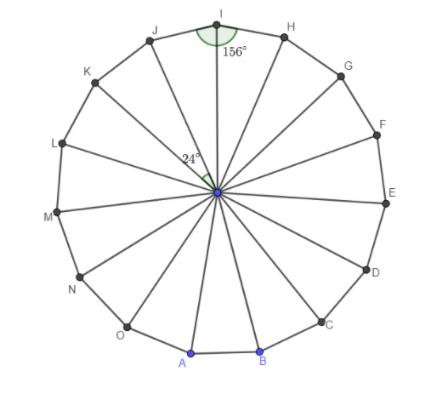
Work out the sizes of one interior angle of a regular polygon 15-sided polygon?
Answer
385.5k+ views
Hint: Use the formula for calculating the measure of each interior angle of a regular polygon, which is given by \[(n-2)\times \dfrac{{{180}^{{}^\circ }}}{n}\], where n represents the number of sides of the regular polygon. One must remember that in a regular polygon, all the sides are of equal length. Use the fact that angles opposite to equal sides are also equal to prove that all the angles of a regular polygon are equal as well.
Complete step by step solution:
We have to calculate the measure of each interior angle of a regular polygon of 15 sides.
Before solving this problem, we need to understand the property of regular polygons. That means the angles which are opposite to equal sides are also equal. As all the sides of a regular polygon are equal, all the angles have equal measure as well.
For more understanding about regular polygon figure is given below

In the above figure that is 15-sided regular polygon, we have to find the interior angles of the polygon.
We know that a regular polygon with ‘n’ sides has the measure of each angle equal to \[(n-2)\times \dfrac{{{180}^{{}^\circ }}}{n}\].
Substituting \[n=15\] in the above formula, the measure of each angle \[=(15-2)\times \dfrac{{{180}^{{}^\circ }}}{15}\]
By simplifying this we get:
\[\Rightarrow 13\times \dfrac{{{180}^{{}^\circ }}}{15}\]
By further solving this we get:
\[\Rightarrow \dfrac{{{1440}^{{}^\circ }}}{15}\]
By reducing fraction, we get:
\[\Rightarrow {{156}^{{}^\circ }}\]
Hence, the value of each angle of a regular polygon with 15 sides is \[{{156}^{{}^\circ }}\].
Note:
A regular polygon is defined as a flat shape whose sides are all equal in length and whose angles are all equal. A regular polygon having 5 sides is called a pentagon. The sum of internal angles of a regular polygon is \[(n-2)\times {{180}^{{}^\circ }}\]. Thus, for a pentagon, the sum of measures is \[{{540}^{{}^\circ }}\]. The sum of all exterior angles of a regular polygon is \[{{180}^{{}^\circ }}\]. The diagonals of a convex regular polygon are in the golden ratio to its sides. One must be careful while calculating the value of interior angles. We will get different measures of angles when measured in degrees and radians.
Complete step by step solution:
We have to calculate the measure of each interior angle of a regular polygon of 15 sides.
Before solving this problem, we need to understand the property of regular polygons. That means the angles which are opposite to equal sides are also equal. As all the sides of a regular polygon are equal, all the angles have equal measure as well.
For more understanding about regular polygon figure is given below

In the above figure that is 15-sided regular polygon, we have to find the interior angles of the polygon.
We know that a regular polygon with ‘n’ sides has the measure of each angle equal to \[(n-2)\times \dfrac{{{180}^{{}^\circ }}}{n}\].
Substituting \[n=15\] in the above formula, the measure of each angle \[=(15-2)\times \dfrac{{{180}^{{}^\circ }}}{15}\]
By simplifying this we get:
\[\Rightarrow 13\times \dfrac{{{180}^{{}^\circ }}}{15}\]
By further solving this we get:
\[\Rightarrow \dfrac{{{1440}^{{}^\circ }}}{15}\]
By reducing fraction, we get:
\[\Rightarrow {{156}^{{}^\circ }}\]
Hence, the value of each angle of a regular polygon with 15 sides is \[{{156}^{{}^\circ }}\].
Note:
A regular polygon is defined as a flat shape whose sides are all equal in length and whose angles are all equal. A regular polygon having 5 sides is called a pentagon. The sum of internal angles of a regular polygon is \[(n-2)\times {{180}^{{}^\circ }}\]. Thus, for a pentagon, the sum of measures is \[{{540}^{{}^\circ }}\]. The sum of all exterior angles of a regular polygon is \[{{180}^{{}^\circ }}\]. The diagonals of a convex regular polygon are in the golden ratio to its sides. One must be careful while calculating the value of interior angles. We will get different measures of angles when measured in degrees and radians.
Recently Updated Pages
What percentage of the area in India is covered by class 10 social science CBSE

The area of a 6m wide road outside a garden in all class 10 maths CBSE

What is the electric flux through a cube of side 1 class 10 physics CBSE

If one root of x2 x k 0 maybe the square of the other class 10 maths CBSE

The radius and height of a cylinder are in the ratio class 10 maths CBSE

An almirah is sold for 5400 Rs after allowing a discount class 10 maths CBSE

Trending doubts
The Equation xxx + 2 is Satisfied when x is Equal to Class 10 Maths

Why is there a time difference of about 5 hours between class 10 social science CBSE

Change the following sentences into negative and interrogative class 10 english CBSE

Write a letter to the principal requesting him to grant class 10 english CBSE

Explain the Treaty of Vienna of 1815 class 10 social science CBSE

Write an application to the principal requesting five class 10 english CBSE




